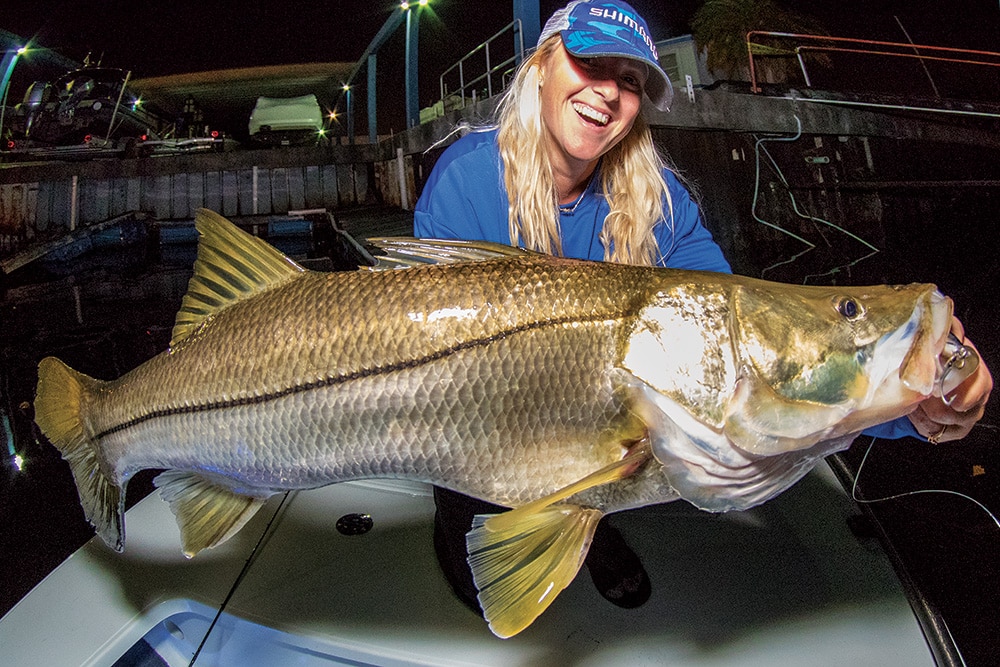
“Who would have thought I’d catch the biggest snook of my life while fishing in my own backyard?”
Regina Gallant, an avid snook angler, posed that rhetorical question the day after she managed that feat.
The evening before, as the sun dipped behind Fort Lauderdale’s soaring high-rise skyline, both Gallant and I had hooked good snook. While she kept hers clear of the nearby pilings, the monster I had on wove my braided line strategically through the structure and broke off.
But we released Gallant’s 49-inch trophy. As we watched that giant fish sweep water with its tail and fade into the amber light of the urban nightscape, Gallant referenced our own twilight zone, explaining, “Well, here we are, all alone with world-class snook, fishing in the middle of a bustling metropolis!”
Current Affairs
After 25 years of chasing trophy snook in the far corners of the Caribbean, South America and even Central America, I can say most anglers would expect such beasts to be caught along exotic shorelines, but not here, in the middle of a jungle of submerged concrete, right in downtown Fort Lauderdale, Florida.
I’ve learned better, from many evenings spent after work fishing the maze of waterways and canals that surround the concrete jungle of Broward County, where I live. While the scenery does not compare with the Everglades or Costa Rica, the canals of Broward County provide more than a thruway for boat traffic. These man-made waters are also home to giant snook.
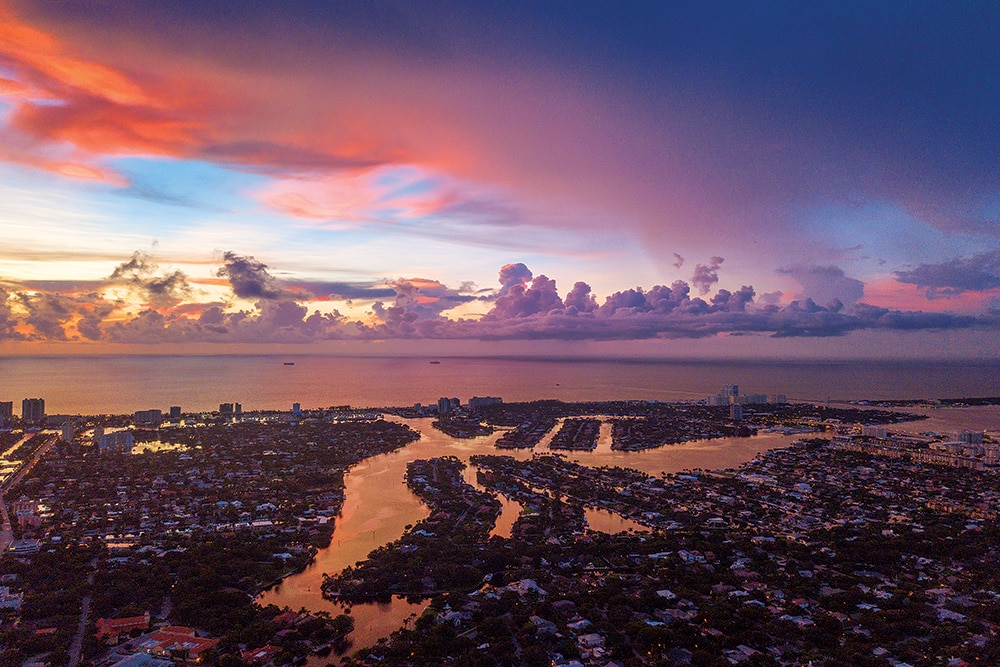
Linesiders are structure-oriented, and you can find them scattered through many tropical urban river systems, often prowling close to bridges, docks, jetties and spillways. Trolling diving plugs works extremely well to locate these snook — especially trophies.
While trolling as a snook strategy hasn’t gained great popularity, the second-largest snook recorded by the International Game Fish Association was actually caught on a trolled plug. George Beck, of Fort Lauderdale, caught his 56-inch 57-pound, 12-ounce snook while trolling a red-and-white Rapala Magnum CD18 at the mouth of Rio Naranjo in Quepos, Costa Rica. That was enough proof for me to start keeping a couple of rods and an assortment of diving plugs in the boat whenever I went out in search of massive linesiders.
Miami-based Capt. Bouncer Smith showed me how to pull plugs in urban waterways during the 1990s. I can still recall the early August morning we were going to head offshore when, motoring through Government Cut, Smith said the tide was just right for snook. He tied on two Rapala Magnum CD18s, one red-and-white and the other orange. Our first pass out of the cut along the north jetty produced an 11-pound fish. On the second pass, we landed a 15-pounder, both on the orange Rapala. After seeing that, I was hooked like a snook on a diving plug.
“When I troll into the current, I may not even be moving,” Smith told me, and his words would prove true several times in my own fishing exploits. Smith keeps his center console almost stationary in the current, just barely sliding forward as he moves parallel to the jetty with a feathered touch of the throttles.
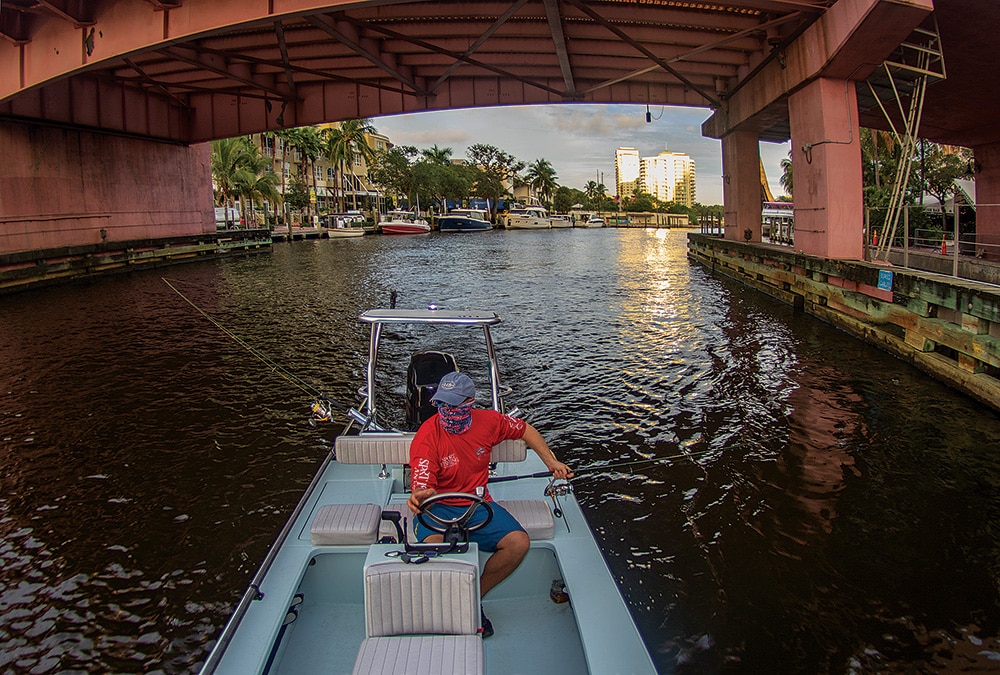
“If I give it more juice, the lures will rise in the water column and get pulled away from where the fish are,” he says.
He also taught me to keep color selections simple. His arsenal consists of four main color choices: light (red and white), dark (black or purple), radically different (orange or bright pink), and a few that match the hatch (natural, silver colors that mimic a mullet). I use these same color principles when fishing tight quarters of urban rivers and canals on my flats boat.
Big Lips, Little Lips
Procuring live bait with only a few hours to spare after work can be a tough endeavor, or — if you must buy it — a costly one. Most of us are not captains who fish day in and day out and consistently know where the fish are. We just don’t have the time. Trolling plugs is my solution.
In the spiderweb of rivers and canals running through Fort Lauderdale and Miami, mullet are the most common forage fish for predators like snook. For that reason, I use plugs that match the profile of a mullet, ranging from 5 to 9 inches in size. If there are larger mullet around, I will fish plugs greater than 10 inches.
When it comes to choosing plugs, I think it’s really true: You get what you pay for. The results achieved from fishing premium-brand lures justify the higher prices they fetch. Larger sporting-goods stores might offer their own copycat models of diving plugs sold for a few dollars less than the brand-name lures, but I don’t waste my money on them. These knockoffs are made with inferior components: soft split rings that fail, cheap hooks that straighten out or plugs with bodies that lose their integrity — and their proper swimming action.
My own go-to plugs for applications deeper than 8 feet: Rapala CountDown Magnum with a metal lip (CDMAG11, CDMAG14 and CDMAG18) and X-Rap Magnum plastic-lipped plugs (XRMAG15, XRMAG20 and XRMAG30), MirrOlure 25+, and Bomber CD series (BSWCD25 and BSWCD30). I’ve also had good success with Halco Laser Pro 160s (LP160 D, LP160 XDD). For shallow-water applications (less than 7 feet), fishing near rock piles and bridges, such as Miami’s 79th Street Causeway, Venetian Causeway and Rickenbacker Causeway, I use smaller-lipped divers: Rapala X-Rap Saltwater (SXR12 and SXR14), X-Rap Jointed Shad (XJS13G) and Bomber Magnum Long A’s.
While these lures are expensive and losing some is inevitable, I’ve recently reduced the number of lost lures by changing out treble hooks to single in-line hooks (Owner 3X 4102-139 and VMC ILS Inline Single 4X ILS#3/0BNPP). I was concerned about decreased hookup ratios, but I’ve found that the single hooks work just as well, and they are easier on fish to be released.
Tackle for Inshore Trolling
High-visibility braided line is a must when trolling diving lures. The sensitivity and strength allow for a controlled presentation in low-light conditions around structure. My preference is for heavy 50- to 65-pound PowerPro that can stand up fairly well to oyster-encrusted docks and bridge pilings. Three to 4 feet of 60-pound or 80-pound fluorocarbon will provide adequate leader length for most conditions. Even longer leader lengths can be an advantage when leadering a fish, and provide some additional abrasion resistance. The trade-off, however, is more of that thick-diameter leader makes for more drag in the water, which can corrupt a plug’s swimming action. Depending on the lure used and the depths fished, along with the speed and direction of current, I place a plug between 30 and 200 feet behind the boat.
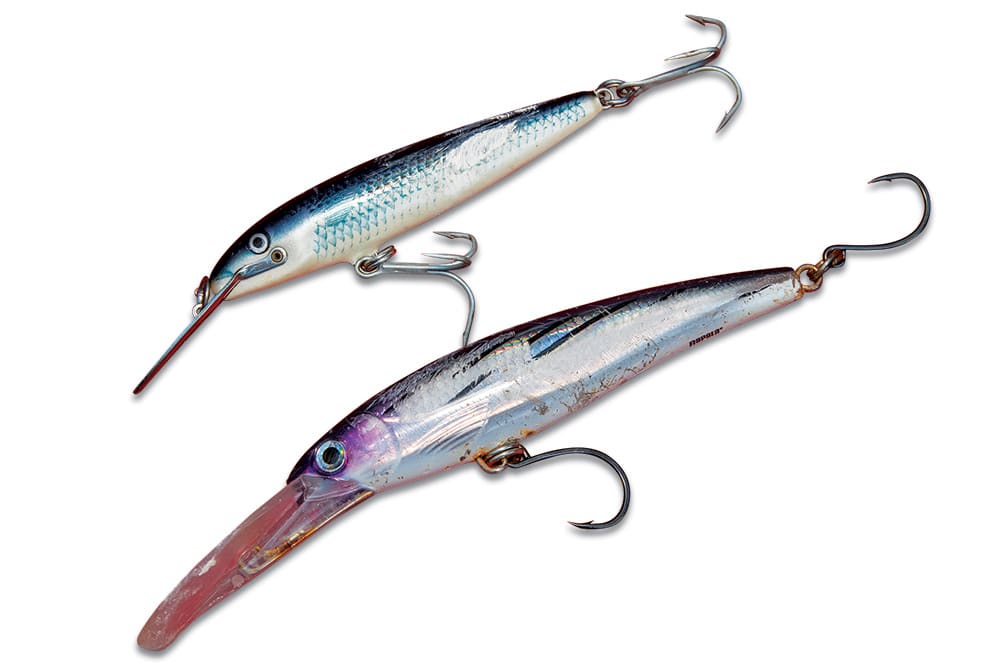
Troll shallow-lipped plugs farther from the boat, say 120 to 200 feet back. Keep deep divers closer, roughly 30 to 120 feet behind the boat when depths range from 6 to 20 feet.
While I’ve had equal success using spinning and conventional tackle, I’m more comfortable trolling with spinning tackle on my flats boat. For me, spinning rods make it easier to deploy plugs in the dark without running the risk of backlashes. In some cases, such as where rivers narrow near bridges, we’ll need to spin the boat around quickly to circle back to the bridge. Casting the plugs a good distance back behind the boat well in advance is crucial, so the plug is at the correct depth and speed by the time it enters the strike zone.
In the confines of a flats boat I troll only two rods — heavy 30- to 50-pound spinning rods with Shimano Stella 10000 reels. Unless I’m alone and have to use a rod holder for the second rod, I always hold the rod when trolling for several reasons. First off, you get to feel the strike. Secondly, the plugs vibrate, and if a piece of debris is picked up you usually can feel it and clear the lure with a few strong ripping motions, and if not, reel it in. Finally, it can be a bit tricky removing a rod from the holder when the boat is underway and the rod is bent over with the force of a running fish. If a snook strikes and runs for cover, your response time when holding the rod is far less.
However you troll, be conscious of your surroundings. It can be a challenge watching trolling rods in the dark of night while staying alert for boat traffic and checking the depth sounder. However, there have been countless times when the bottom came up rapidly on the sonar and I had to quickly pull the lure closer to the boat to hook fish (versus bottom) along those drop-offs and ledges.
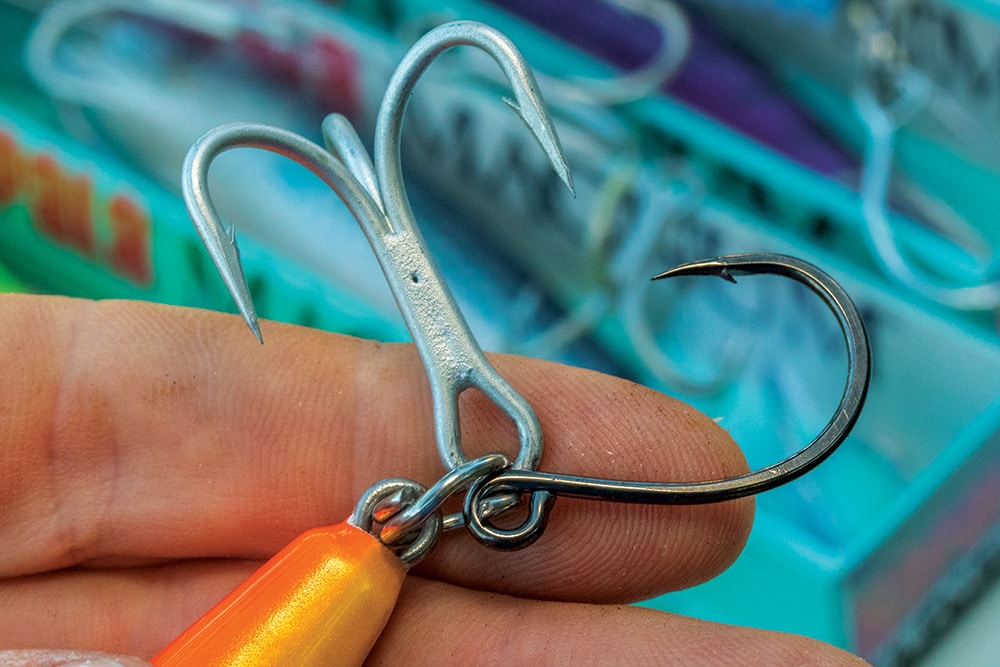
Tom Greene, owner of Tom Greene Custom Rod and Gun in Fort Lauderdale, is a veteran southeast Florida snook guru. He swears that holding and “working” the rod while trolling will almost always outcatch straight dead-pulling a plug from a rod holder. He tabulated on one outing that he had three times as many strikes while holding and working a plug compared to another angler who left his rod in the rod holder. They were running the exact same plugs on the same rod, reel and line combinations.
Tide and Current
Trolling against the current tends to raise diving plugs higher in the water column; paying out more line helps the lure run deeper. In some instances, a deep-diving plug can require up to 200 feet of line to keep the lure running near the bottom in 10- to 12-foot depths when the water is moving at 3 to 4 knots. During those times, I turn to Smith’s strategy of slowing down the revolutions per minute so the boat almost seems to be holding in place in the current.
Trolling with the current requires less scope to keep the lures down. Find the “sweet-spot” speed/rpm where the lure starts to wobble the rod tip without moving too fast past the structure and fish. But at the same time, keeping the lure too close to the boat can be counterproductive. The boat can spook the fish as it passes overhead. It’s a fine balance.
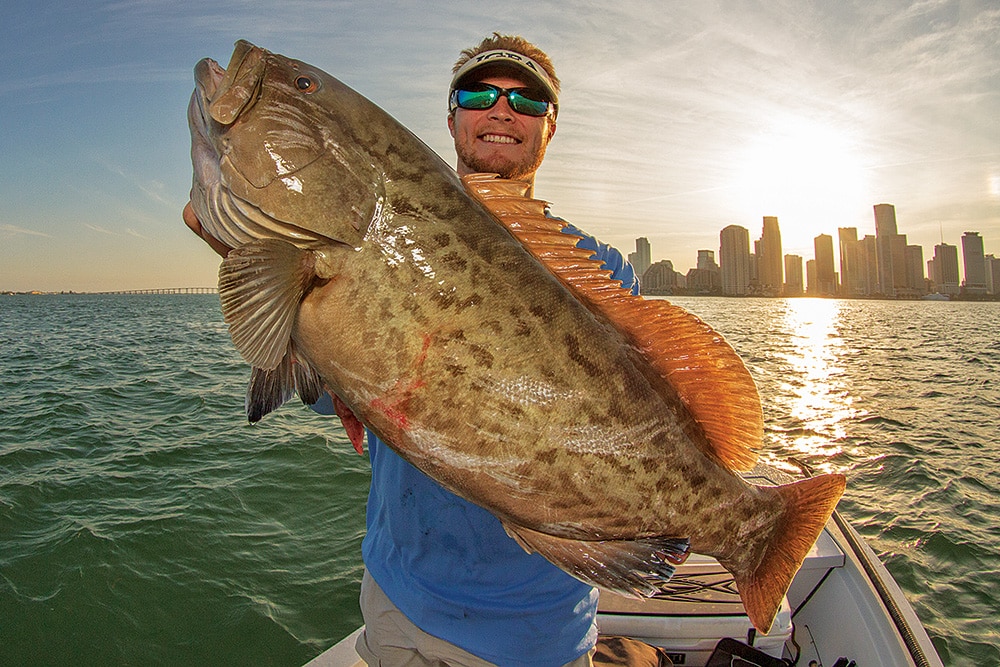
We also crisscross back and forth through canals, making passes near structure that might hold snook.
When large volumes of water run through the rivers during lunar flood tides, or when the spillways are opened due to high rainfall, it’s usually a productive time to troll plugs. For example, during a November evening when a stronger-than-normal flood tide roared through the double spans of Davie Boulevard Bridge, by trolling a bonito-colored Rapala X-Rap 30 with the direction of the strong current, we caught an estimated 30-plus-pound snook. We also caught two snook, 34 and 36 inches, on the same exact lure. The X-Rap 20 of the same color pattern on the second rod was not swimming deep enough. When the flood gates along state road 84 were opened in June due to high precipitation, we did especially well, catching fish all along the multiple narrower spanned bridges of the New River.
Structure Is Everything
While we have caught snook and sometimes tarpon trolling blindly through much of Fort Lauderdale’s New River, Miami’s Miami River and the Intracoastal Waterway, it is much more productive concentrating time and effort near structure. On occasion, especially October through May, we sometimes catch gag grouper on the plugs, especially around the bridges.
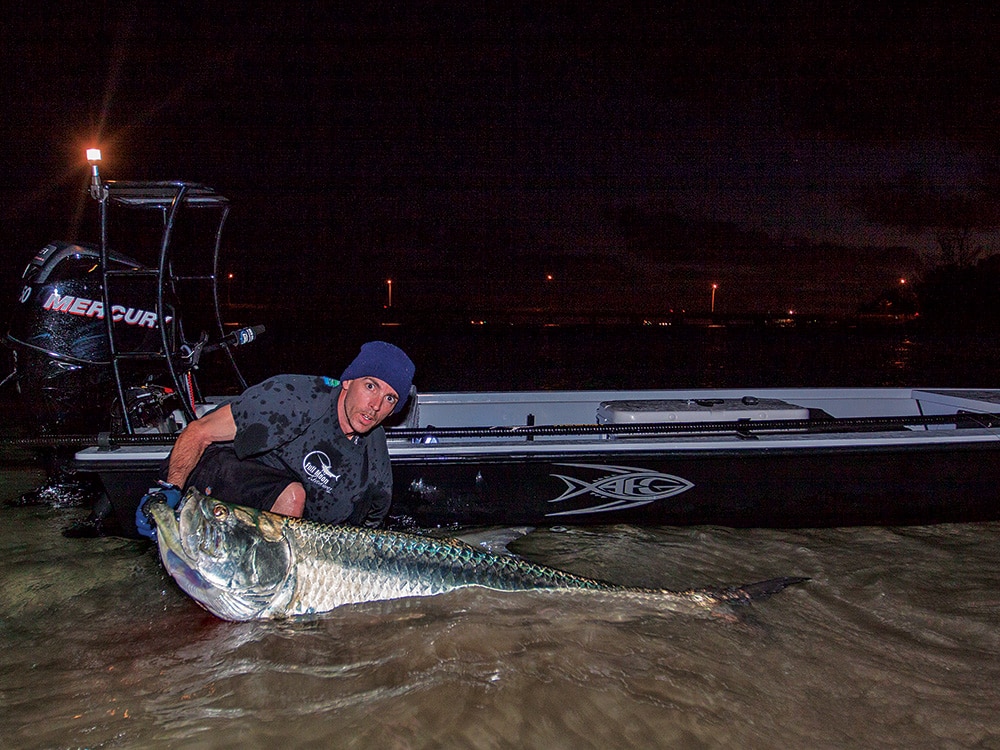
The biggest snook we’ve caught have come on plugs trolled around bridges and docks where there is good current flow. Concentrate efforts wherever you find spots for these ambush feeders — sharp points, pilings, bumpers, irregular bottom contours and, at night, the shadow lines from lights on the bridge. The snook will lie like trout resting in eddies behind rocks, only the snook do this behind bridge pilings. When there is strong current, the structure acts as a respite from fast-moving water. Troll close to the pilings. I try to do this by positioning the boat so the braided line enters the water as close to the pilings as possible along whichever side of the bridge the closest rod passes by.
We catch large female snook year-round trolling the rivers of Fort Lauderdale and Miami. My longtime friend and retired snook biologist Ron Taylor, from Florida Fish and Wildlife, learned from telemetry tracking data that as many as one-third of a breeding stock of snook skip their annual spawn. “Not all of them head out to the inlets to sow their oats from June through September, which is contrary to what we had believed for many years,” he says. And if those fish are not stacked during the spawn aggregation at inlets such as Port Everglades, Haulover or Government Cut, there is a good chance they are in the rivers and ICW year‑round.
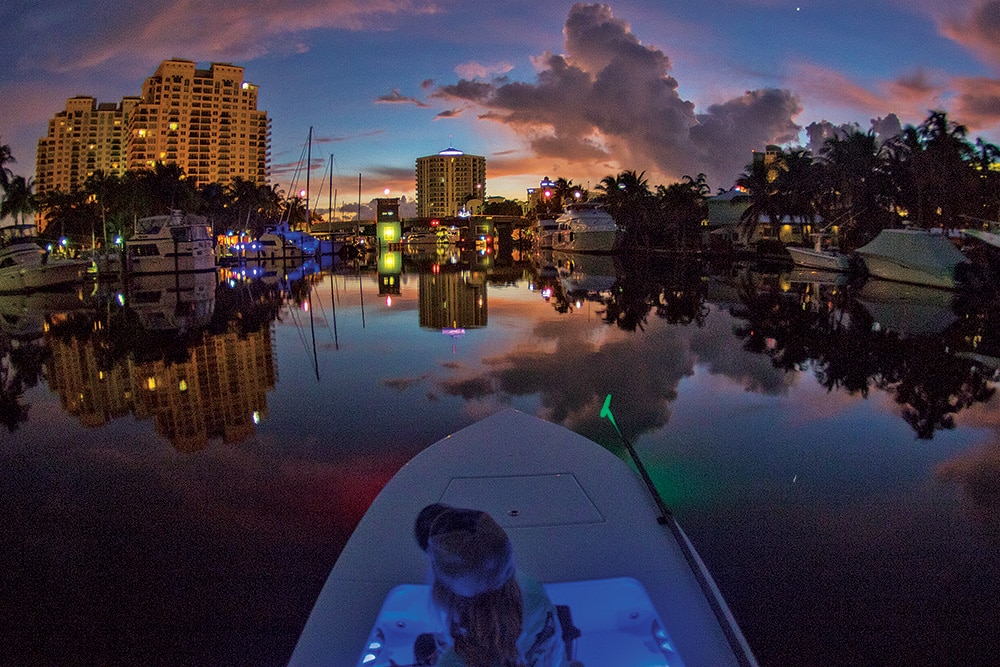
Storage Tips for Plugs
It is notoriously difficult to keep diving plugs free and untangled from each other in my standard Plano 3400 trays. I use the 3400s for long-term storage, but I fabricated a more efficient container for storing multihook dive plugs that makes life easier when I’m on my skiff rummaging for plugs in the dark. The box is a plastic square container (or you could use a milk crate) filled with 10-inch sections of 2-inch PVC pipe. No more fumbling with tangled lures; they slide neatly in and out of the PVC tubes.
About the Author
Adrian E. Gray is an artist and marine photographer specializing in fishing, underwater and marine-related media. Born in South Africa, Adrian lives in South Florida, where he works as the full-time creative staff for the International Game Fish Association.








